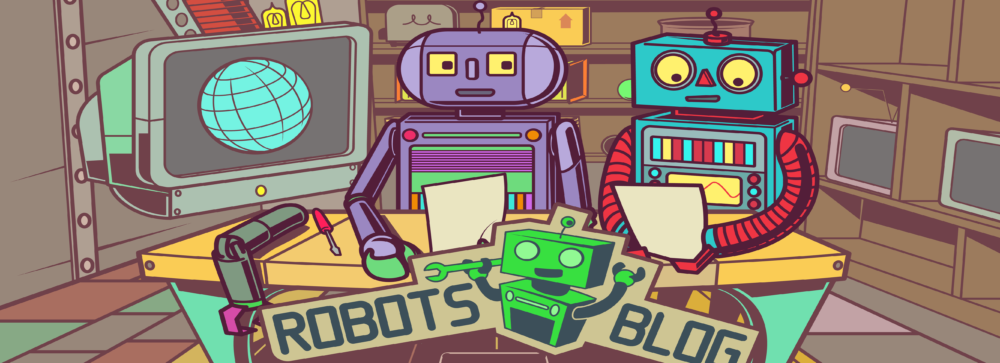Schlagwort-Archiv: Robot
Market launch: New Ensenso N models for 3D and robot vision
Upgraded Ensenso 3D camera series now available at IDS
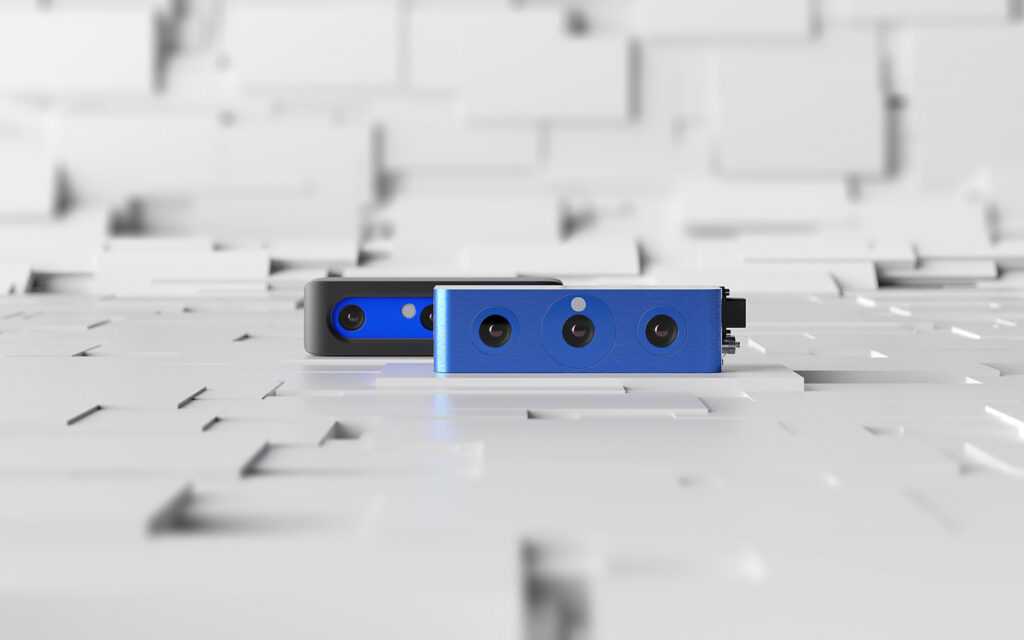
Resolution and accuracy have almost doubled, the price has remained the same – those who choose 3D cameras from the Ensenso N series can now benefit from more advanced models. The new stereo vision cameras (N31, N36, N41, N46) can now be purchased from IDS Imaging Development Systems.
The Ensenso N 3D cameras have a compact housing (made of aluminium or plastic composite, depending on the model) with an integrated pattern projector. They are suitable for capturing both static and moving objects. The integrated projector projects a high-contrast texture onto the objects in question. A pattern mask with a random dot pattern complements non-existing or only weakly visible surface structures. This allows the cameras to deliver detailed 3D point clouds even in difficult lighting conditions.
With the Ensenso models N31, N36, N41 and N46, IDS is now launching the next generation of the previously available N30, N35, N40 and N45. Visually, the cameras do not differ from their predecessors. They do, however, use a new sensor from Sony, the IMX392. This results in a higher resolution (2.3 MP instead of 1.3 MP). All cameras are pre-calibrated and therefore easy to set up. The Ensenso selector on the IDS website helps to choose the right model.
Whether firmly installed or in mobile use on a robot arm: with Ensenso N, users opt for a 3D camera series that provides reliable 3D information for a wide range of applications. The cameras prove their worth in single item picking, for example, support remote-controlled industrial robots, are used in logistics and even help to automate high-volume laundries. IDS provides more in-depth insights into the versatile application possibilities with case studies on the company website.
Learn more: https://en.ids-imaging.com/ensenso-3d-camera-n-series.html
Robotic Vision Platform Luxonis Announces its First Open Source Personal Robot, rae
LITTLETON, Colo., 2022 /PRNewswire/ — Luxonis, a Colorado-based robotic vision platform, is thrilled to introduce rae, its first fully-formed and high-powered personal robot. Backed by a Kickstarter campaign to help support its development, rae sets itself apart by offering a multitude of features right out of the box, along with a unique degree of experimental programming potential that far exceeds other consumer robots on the market. The most recent of a long line of Luxonis innovations, rae is designed to make robotics accessible and simple for users of any experience level.
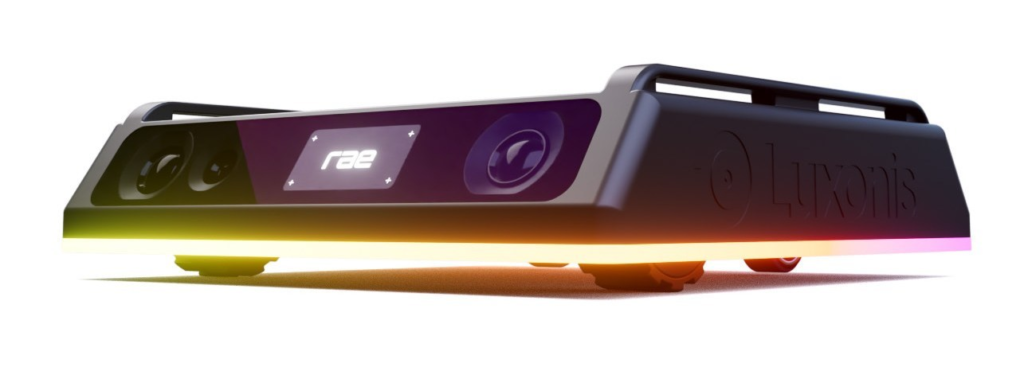
„rae is representative of our foremost goal at Luxonis: to make robotics accessible and simple for anyone, not just the tenured engineer with years of programming experience,“ said Brandon Gilles, CEO of Luxonis. „A longstanding truth about robotics is that the barrier to entry sometimes feels impossibly high, but it doesn’t have to be that way. By creating rae, we want to help demonstrate the kinds of positive impacts robotics can bring to all people’s lives, whether it’s as simple as helping you find your keys, talking with your friend who uses American Sign Language, or playing with your kids.“
At its core, rae is a world-class robot, and includes AI, computer vision and machine learning all on-device. Building upon the technology of the brand’s award-winning OAK cameras, rae offers stereo depth, object tracking, motion estimation, 9-axis IMU data, neural inference, corner detection, motion zooming, and is fully compatible with the DepthAI API. With next-generation simultaneous localization and mapping (SLAM), rae can map out and navigate through unknown environments, and is preconfigured with ROS 2 for access to its robust collection of software and applications.
Featuring a full suite of standard applications, rae offers games like follow me and hide and seek, and useful tools like barcode/QR code scanning, license plate reading, fall detection, time-lapse recording, emotion recognition, object finding, sign language interpretation, and a security alert mode. All applications are controllable through rae’s mobile app, which users can use from anywhere around the world. They can also link with Luxonis‘ cloud platform, RobotHub, to manage customizations, download and install user-created applications, and collaborate with Luxonis‘ user community.
Crowdfunding campaigns and developing trailblazing products that roboticists love is something that is in Luxonis‘ DNA, which is made evident by its established track record of two previously successful campaigns. Luxonis‘ first Kickstarter for the OpenCV AI Kit in 2021 raised $1.3 million with 6,564 backers, and the second for the OAK-D Lite raised $1.02 million with 7,988 backers. With the support of robot hobbyists and brand loyalists, as well as new target backers such as educators, students, and parents, rae is en route to leave an impact as a revolutionary personal robot that isn’t limited to niche demographics.
Pricing for rae starts at $299 and international shipping is available.
Interested backers can learn more about the campaign here.
For more information about Luxonis, visit https://www.luxonis.com/
About Luxonis:
The mission at Luxonis is robotic vision, made simple. They are working to improve the engineering efficiency of the world through their industry leading and award winning camera systems, which embed AI, CV, and machine learning into a high performing, compact package. Luxonis offers full-stack solutions stretching from hardware, firmware, software, and a growing cloud-based management platform, and prioritizes customer success above all else through the continued development of their DepthAI ecosystem.
AGILOX introduces new ODM robot
AGILOX expands its product portfolio with an intelligent dolly mover

After AGILOX ONE and AGILOX OCF, now comes AGILOX ODM. The company, which specializes in logistics robots, is adding an autonomous dolly mover to its range of intelligent transport systems controlled by swarm intelligence. AGILOX is thus targeting a completely new area of application: the transport of small load carriers.
AGILOX is expanding its range of Autonomous Mobile Robots (AMRs) with the new Omnidirectional Dolly Mover AGILOX ODM. While the AGILOX ONE is equipped with a scissor lift and the AGILOX OCF has a free lift for load handling, the AGILOX ODM is built on the principle of a dolly mover. This means it can accept loads with a maximum weight of 300 kg to a maximum lifting height of 250 mm and transport them to their destination. The intelligent AMR concept with AGILOX X-SWARM technology thus opens up new areas of application and other industry segments because small load carriers (such as totes), which the new AGILOX ODM is designed to transport, are widely used, especially in the electronics and pharmaceutical industries.
Details of the new AGILOX ODM
With the AGILOX ODM, AGILOX has brought new thinking to the concept of Automated Guided Vehicles: The compact vehicle travels autonomously and navigates freely on the production floor or in the warehouse, perfectly ensuring the in-house material flow. Just like AGILOX ONE and AGILOX OCF, AGILOX ODM uses an omnidirectional drive concept. This allows it to travel transversely into rack aisles as well as turn on the spot, enabling it to maneuver even in the tightest of spaces. The lithium iron phosphate (LiFePO4) accumulator ensures short charge times and long operating cycles.
“AGILOX is a brand that has built a strong foundation with the AGILOX ONE and the AGILOX OCF. With the new AGILOX ODM, we remain true to our brand DNA while simultaneously targeting the transport of small load carriers to support our growth plan to become the world’s leading AMR provider,” says Georg Kirchmayr, CEO of AGILOX Services GmbH.
The AGILOX advantage
With the new AGILOX ODM, customers can benefit from all the advantages of same proven X-SWARM technology as in AGILOX ONE and AGILOX OCF: the unique advantages of an (intra-)logistics solution designed from the ground up.
Since AGILOX AMRs have no need for a central control system and can orient to the existing contours with millimeter precision, this eliminates time-consuming and costly modifications to the existing infrastructure. Autonomous route-finding also enables the vehicles to avoid obstacles unaided. If it is not possible to get past the detected obstacle due its size or the available clearance, the AMRs calculate a new route within seconds to reach their destination as quickly as possible. For customers, this means maximum freedom in their existing processes, because they do not have to adapt to the Autonomous Mobile Robot system. Instead, the system adapts to the customer’s processes. Furthermore, fully autonomous routing ensures a safe workflow – even in mixed operations.
Plug & Perform commissioning of the intelligent intralogistics solutions and the absence of a master computer or navigation aids also saves AGILOX customers from doing tedious alteration work in advance. Once the logistics robots have been put into operation, they organize themselves according to the (decentralized) principle of swarm intelligence, i.e. they exchange information several times a second to enable the entire fleet to calculate the most efficient route and prevent potential deadlocks before these can occur. The customer thus benefits from a system that constantly runs smoothly, with no downtime. Time-consuming coordination of vehicles by the customer is also a thing of the past thanks to AGILOX X-SWARM technology. For the customer, this means flexibility, because it lets them expand the vehicles‘ area of operation within just a few minutes. It also means that it is very easy to relocate an AGILOX AMR to be used temporarily in other areas of the company areas or its subsidiaries. Since AGILOX vehicles can also communicate with other machines or the building infrastructure by means of IO boxes, even rolling doors or multiple floors are no problem for the AMRs. So, this too means that customers enjoy maximum flexibility in the organization of their production processes.
Another major advantage comes from mixed operation of the AGILOX fleet in a “swarm”. The smaller AGILOX ONE and ODM series vehicles can then, for example, feed the assembly workstations or e-Kanban racks, while the AGILOX OCF vehicles transport the pallets. This can easily be done because AGILOX AMRs all use the same control and WiFi infrastructure.
Could Robotic Scuba Divers Reach The Bottom Of The Ocean?
Guest Article by Ellie Poverly - Ellie is an online journalist specializing in robotics and science research. She is also the Managing Editor at Revolutionized Magazine. As of 2022, roughly 80% of the ocean remains a mystery. In fact, much of it hasn’t even been seen by humans yet. There have been more photographs of the Moon’s surface than the ocean floor.
Exploring the deepest parts of the ocean is an incredible challenge, complicated by intense pressures and complete darkness. Here’s a look at the robots that could finally reveal the secrets of Earth’s oceans.
The Limits of Human Exploration
Over half of the tallest mountain on Earth is underwater. The volcano Mauna Kea in Hawai’i is estimated to be around a mile taller than Mt. Everest from base to peak, although most of it is submerged. This massive volcano is just one of countless secrets hiding beneath the surface of Earth’s oceans.
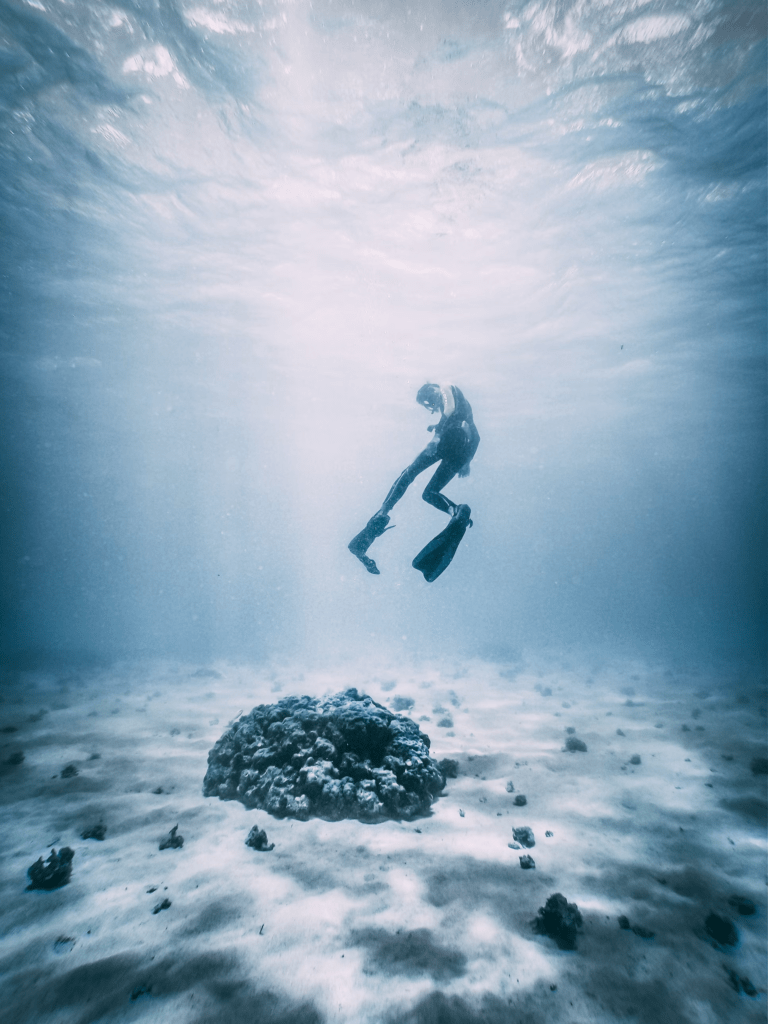
Other discoveries waiting underwater range from the wrecks of lost aircraft to the remains of sunken ships and even sunken cities, as well as life that looks like something from an alien world. Exploring the ocean floor could reveal groundbreaking archaeological, geological and biological discoveries. So, why haven’t humans started SCUBA diving down to the seabed?
Unfortunately, reaching the ocean floor is not easy, especially for humans. The deepest part of the ocean is the Mariana Trench, which extends 7 miles — or about 36,200 feet — deep. To put that into perspective, the world record for the deepest SCUBA dive is only 1,090 feet, set by diver Ahmed Gabr in 2014. Approximately 1,000 feet below sea level is considered the maximum depth humans can dive.
Luckily, humans have invented some amazing robots to help explore the ocean floor remotely.
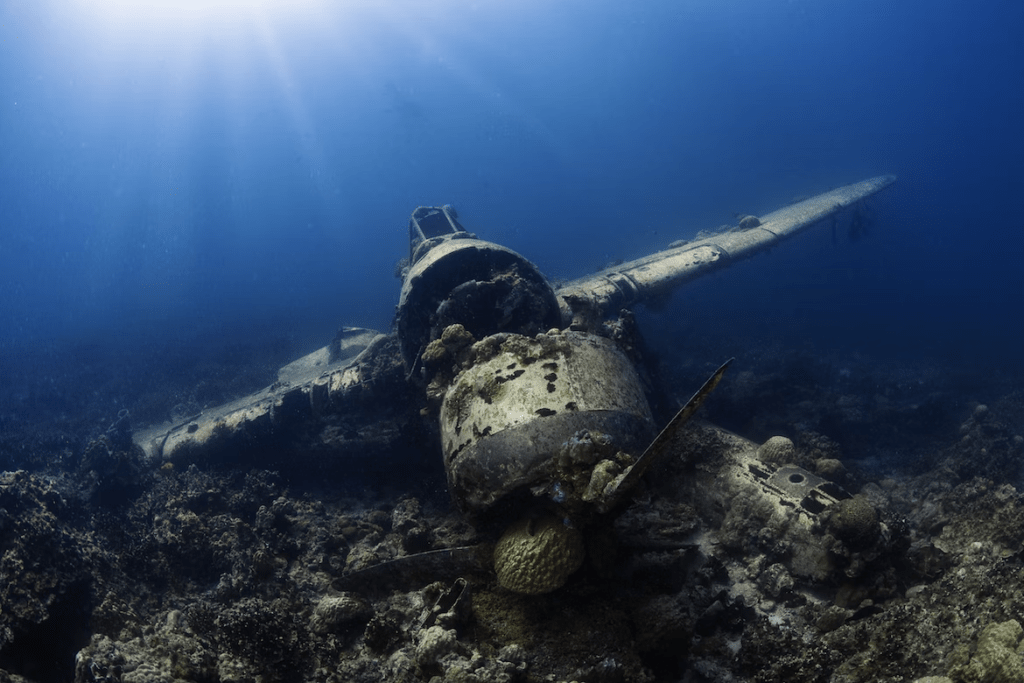
The Robotic SCUBA Divers Exploring the Depths
A growing number of robotic SCUBA divers travel down to the deepest reaches of the ocean. Some look like mini submarines, while others are eerily human-like. These robots help scientists study a wide range of topics and may become even more crucial in the years ahead.
For instance, climate change increases the risk of food toxins on the surface. Could this be happening underwater as well? Additionally, the strange biology of deep-sea life could help researchers learn more about how life evolved on Earth and how it might exist on other worlds.
The Woods Hole Oceanographic Institution has explored depths of 36,000 feet below sea level in the Mariana Trench using a robotic submarine called Orpheus. The robot is helping create 3D imaging of the ocean floor and capture video footage of deep-sea life. Its navigation system may one day be used in robots that explore the dark oceans of the moons of Jupiter and Saturn.

Taking a completely different approach is the OceanOne robotic SCUBA diver developed by researchers at Stanford University. The OceanOne is designed to be as human-like as possible, acting as a robotic avatar for human divers. On its maiden voyage in 2016, OceanOne was used to retrieve the first treasures ever recovered from the flagship of King Louis XIV, wrecked in 1664. Humans have never touched the wreck before.
NASA is also developing a deep-sea robot — the Aquanaut — which features a humanoid design. The Aquanaut has front-mounted cameras and sensors, as well as robotic arms engineers can connect various tools to. Unlike other deep-sea robots, the Aquanaut is geared more toward underwater work than exploration. However, NASA still plans to use robots to explore the oceans of Europa and Enceladus, frozen moons of Jupiter and Saturn, respectively.
What the Robot Divers are Discovering
These robotic SCUBA divers are making incredible discoveries at the bottom of the ocean. For starters, robots are helping scientists map the ocean floor, which is a monumental undertaking. Robots that dive down to the seabed need to withstand immense pressures that would kill a human diver. Plus, all of the robot’s instrumentation, sensors, cameras and navigation electronics must be able to survive, as well.

In addition to mapping the ocean floor, robotic SCUBA divers are helping humans find new species of aquatic life. The seabed seems like an unlikely place for life — it is entirely devoid of sunlight and freezing. However, robotic deep-sea exploration has changed how scientists think about the necessary ingredients for life.
Dozens of new species have been discovered living in the darkness of the deep oceans. They range from colossal squids to strange life forms that look like something straight out of science fiction. Many deep-sea animals do not have eyes since there is no light on the ocean floor. Others have evolved to be far larger than their higher-depth cousins, such as enormous jellyfish and crabs.
The Future of Robotic SCUBA Divers
Robots are taking exploration to new horizons that would otherwise be unattainable for humans. Earth’s oceans remain some of the least explored regions in the solar system. With the help of robotic SCUBA divers, scientists are discovering new species, unearthing ancient shipwrecks and revolutionizing knowledge of the sea.
Kivnon brings perfect Pallet Stacking to Logistics & Automation 2022
Kivnon will be presenting its most advanced and safest AGV/AMR Forklift at the event
21 September 2022, Barcelona: Kivnon, an international group specializing in automation and mobile robotics, is attending Logistics & Automation in Spain and will be showcasing it’s safe and versatile K55 AGV/AMR Forklift Pallet Stacker. Putting the emphasis on forklift safety, Kivnon K55 is equipped with advanced safety features to guarantee safe operations as it collaborates, moves, and reacts in a facility.
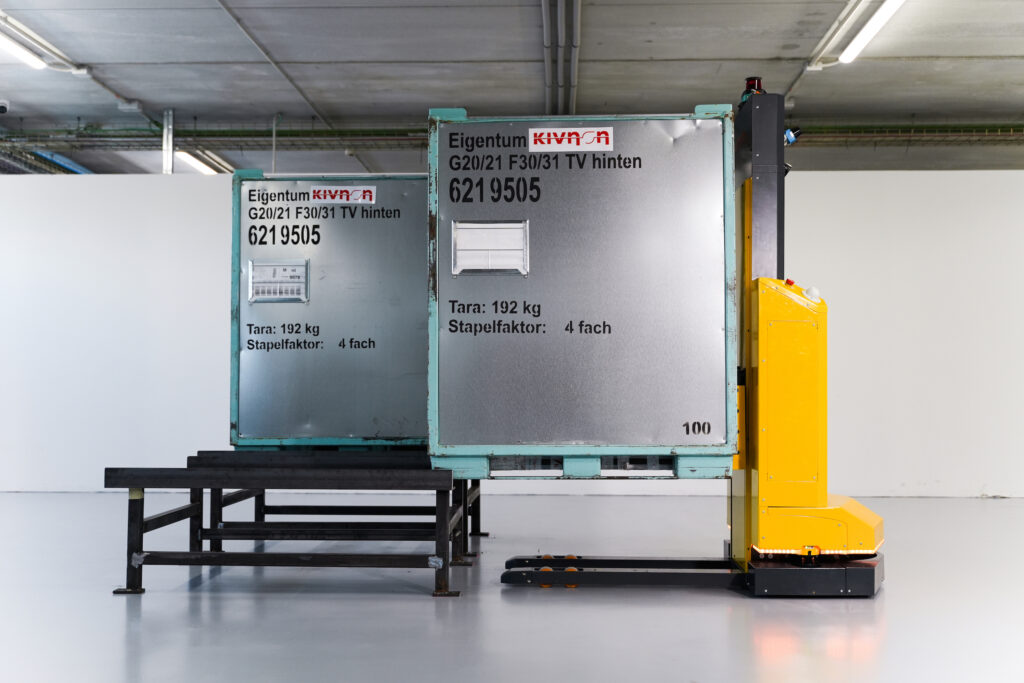
The Kivnon K55 is designed to move and stack palletized loads at low heights and performs cyclic or conditioned routes while interacting with other AGVs/AMRs, machines, systems, and people, making it a highly effective and safe solution. The model incorporates safety scanners that allow the vehicle to ensure 360-degree safety and operate seamlessly in shared spaces. The fork sensors help assess the possibility of correct loading or unloading of the pallet, keeping the transported goods safe.
Thierry Delmas, Managing Director at Kivnon, says, “AGVs/AMRs are revolutionizing internal logistics. The rising forklift safety challenge is of deep concern, and with the K55 we have taken a step forward to address the global issue. The Kivnon range is designed to ensure safe and reliable operations and to optimize operational efficiency.“
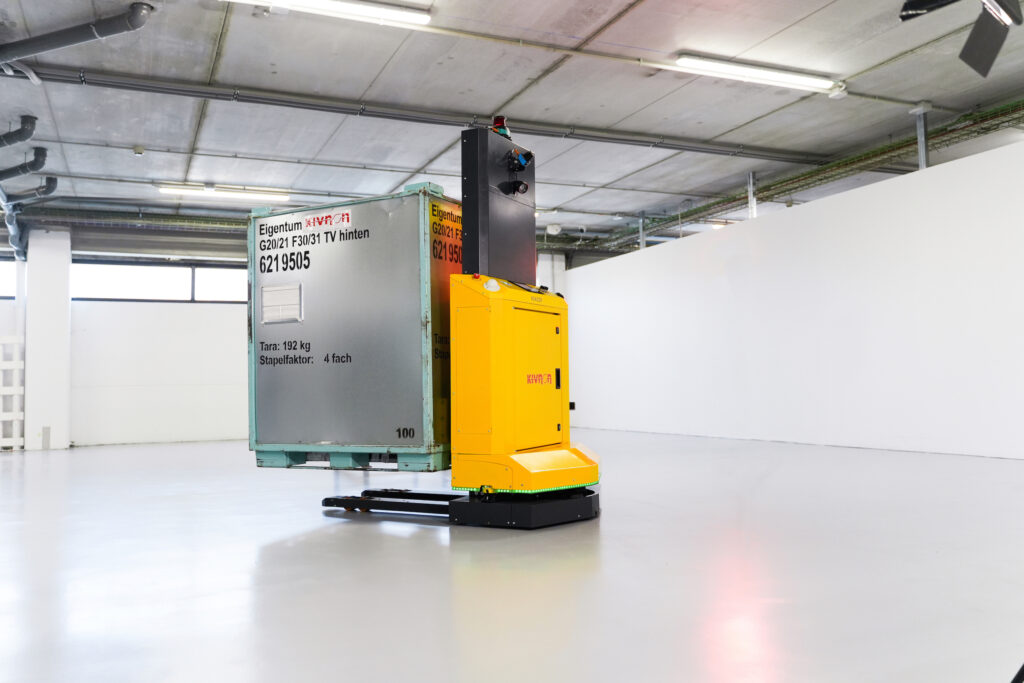
During the event, which runs from 26 – 27 October at IFEMA, Madrid, Kivnon will demonstrate the capabilities of the K55 Pallet Stacker. The vehicle can autonomously transport palletized loads of up 1,000 kg and lift them to heights of up to 1 meter. The vehicle is capable of performing cyclical or conditional circuits and interacting with other AGVs/AMRs, machines, and systems. Highly adaptable, the K55 is perfect for any open-bottom or euro-pallet storage application, receipt and dispatch of goods, and internal material transport. Its use will optimize safety, storage space, and process efficiency.
A robust industrial product, the K55 provides the reliability required to ensure continuity of production process and flexibility to adapt to specific application needs, with an online battery charging system that can function 24/7 with opportunity charges.
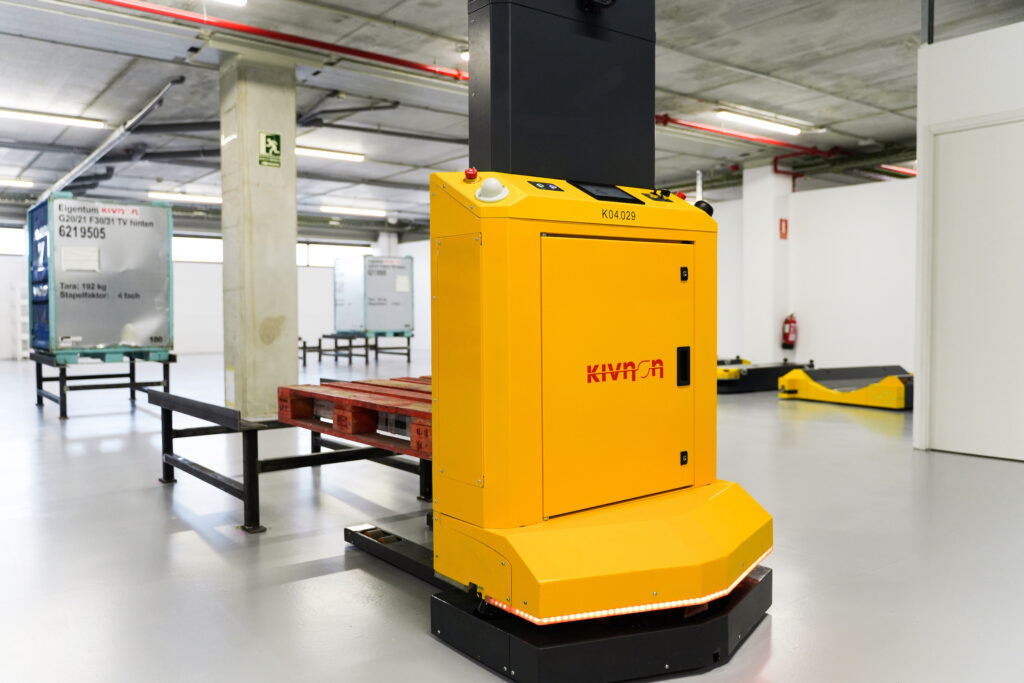
Delmas continues, “The Logistics and Automation show is an important networking event where customers can learn about the latest technologies and innovations. We pride ourselves on innovation and are excited to have this opportunity to showcase the capabilities of our products. In addition to the K55, our robust portfolio also includes twister units, car and heavy load tractors, low-height vehicles, and cart pullers, meeting multiple application needs”
The efficiency and precision of Kivnon AGVs/AMRs will be on display and Kivnon robotics experts will be available throughout the show to answer questions and arrange consultations at booth #3F43.
To register for the show, please visit https://www.logisticsautomationmadrid.com/en/
About Kivnon:
Kivnon offers a wide range of autonomous vehicles (AGVs/AMRs) and accessories for transporting goods, using magnetic navigation or mapping technologies that adapt to any environment and industry. The company offers an integrated solution with a wide range of mobile robotics solutions automating different applications within the automotive, food and beverage, logistics and warehousing, manufacturing, and aeronautics industries.
Kivnon products are characterized by their robustness, safety, precision, and high quality. A user-friendly design philosophy creates a pleasant, simple to install, and intuitive work experience.
Learn more about Kivnon mobile robots (AGVs/AMRs) here.
Austin-based Apptronik Inks Partnership with NASA for Humanoid Robots

AUSTIN, TEXAS (PRWEB) SEPTEMBER 20, 2022
Apptronik, an Austin-based company specializing in the development of versatile, mobile robotic systems, is announcing a partnership with NASA to accelerate commercialization of its new humanoid robot. The robot, called Apollo, will be one of the first humanoids available to the commercial markets.
At Apptronik’s headquarters in Austin, Texas, the first prototype of Apollo is now complete, with the expectation of broader commercial availability in 2023. Unlike special-purpose robots that are only capable of a single, repetitive task, Apollo is designed as a general-purpose robot capable of doing a wide range of tasks in dynamic environments. Apollo will benefit workers in industries ranging from logistics, retail, hospitality, aerospace and beyond.
NASA is known across the globe for its contributions to the advancement of robotics technology. NASA first partnered with Apptronik in 2013 during the DARPA Robotics Challenge (DRC), where founders were selected to work on NASA’s Valkyrie Robot. The government agency has now selected Apptronik as a commercial partner to launch a new generation of general-purpose robots, starting with Apollo.
“Continued investment from NASA validates the work we are doing at Apptronik and the inflection point we have reached in robotics. The robots we’ve all dreamed about are now here and ready to get out into the world,” said Jeff Cardenas, CEO and co-founder of Apptronik. “These robots will first become tools for us here on Earth, and will ultimately help us move beyond and explore the stars.”
In addition to its work with NASA, Apptronik’s team has partnered with leading automotive OEMs, major transportation and logistics companies, and government agencies. Boasting notable names including Dr. Nicholas Paine, Co-founder and Chief Technology Officer of Apptronik and Dr. Luis Sentis, Co-Founder and Scientific Advisor, its team is respected as among the best in the world. A growing hub for robotics, the Austin-based company continues to recruit top talent looking to bring their innovations to market now.
Apptronik is recognized for its emphasis on human-centered design, building beautifully designed and user-friendly robotic systems. As part of this commitment, it selected premier design firm argodesign as its partner in designing Apollo with the goal of creating robots capable of working alongside humans in our most critical industries. The team’s focus now is to scale Apollo so that it can be customer-ready in 2023.
About Apptronik:
Apptronik is a robotics company that has built a platform to deliver a variety of general-purpose robots. The company was founded in 2016 out of the Human Centered Robotics Lab at the University of Texas at Austin, with a mission to leverage innovative technology for the betterment of society. Its goal is to introduce the next generation of robots that will change the way people live and work, while tackling some of our world’s largest challenges. To learn more about careers at Apptronik, visit https://apptronik.com/careers/.
NUWA Introduces RobotCreator DX, A Fully Customizable AI Robot From Inside Out
RobotCreator DX offers intuitive software interfaces to make customization and interaction with the robot unintimidating for beginners and advanced users alike.
Taipei, Taiwan, 07 July, 2022 – NUWA announced on Kickstarter, the all-new RobotCreator DX, a highly customizable AI robot companion designed for users of all levels of skills.
Featuring numerous web-based editing software and a wide array of sensors, RobotCreator DX can be programmed to perform complicated tasks including voice recognition, video calls, interactive games, and many more.
Thanks to the advanced RoFlow Workflow interface, users can effortlessly program the robot to perform various tasks without prior coding knowledge. On the other hand, Trainkit allows users to train DX to chat and respond with physical motions, images or videos.

Notable features include:
- Roflow: A powerful cloud-based visual programming software that allows users to easily customize the robot’s behavior. Users can tap into the vast resources and functions of the robot without prior programming skills.
- CodeLab: An easy-to-use coding center for RobotCreator DX. CodeLab can be accessed from computers, mobile devices, or the DX itself. Natively supports MQTT, CodeLab allows for cross-device control and connection.
- Content Editor: A timeline-based motion editing software designed to program the robot to perform sophisticated movements with its built-in expression and movement library.
- Trainkit: A chatbot dialogue design tool with fuzzy language matching. Trainkit allows users to add body movement, as well as images or videos to the response.
- Quiz Editor: Quiz Editor allows users to design and create interactive games where the fun never ends. Interaction can be made using the integrated touch and audio sensors.
- Skin Editor: A web-based editing software that allows users to create dynamic facial expressions for RobotCreator DX. Users can utilize the built-in templates or create their own with Adobe Photoshop or Illustrator.
- MakerBase: As one of the pillars of the NUWA platform, users can connect with DX fans across the world and share resources like the code, design, and more.

RobotCreator DX Pricing and Availability
Early Bird pledges for RobotCreator DX are now available for a limited amount on Kickstarter for $599, which is more than 40% off the future retail price.
For the complete list of all available backing options and more product details, jump over to the official RobotCreator DX crowdfunding campaign page by clicking the link below.

About NUWA
Founded in Taipei, Taiwan in 2016, NUWA Robotics has extensive experience in AI, software/hardware development, interactive content, and mass production. We have experts across different fields to design and create a robot that can establish a deeper connection with humans. NUWA envisions a world where everyone has a robot companion that provides beyond just responses to commands, but one that can support emotional needs.
Potenziale KI-gestützter Robotik für die Industrie
Künstliche Intelligenz (KI) gilt als Schlüsseltechnologie und birgt enormes wirtschaftliches Potenzial. Doch ein Blick in deutsche Produktionshallen zeigt noch ein anderes Bild: Lediglich 6,8 Prozent der Unternehmen aus den Bereichen Maschinenbau und Elektrotechnik setzen KI-Technologien ein (Stand 2019). Dabei birgt KI gerade für das produzierende Gewerbe zahlreiche Potenziale.
Künstliche Intelligenz ist ein Überbegriff, der den Ansatz beschreibt, mit Maschinen Probleme zu lösen und menschliche Intelligenz zu imitieren. Dabei spielt insbesondere ein Teilbereich, das Machine Learning (Maschinelles Lernen), in Unternehmen und Produktionen eine entscheidende Rolle. Machine Learning bedeutet, dass ein System aus Beispielen lernt und diese nach der Lernphase verallgemeinern kann.
In der Produktion kommt Machine Learning beispielsweise im Bereich Predictive Analytics zum Einsatz. Dort wird KI als Teil von Vorhersagemodellen zur Überwachung und Wartung von Produktionsanlagen eingesetzt, um frühzeitig auf kritische Zustände reagieren zu können.
Auch das Wissensmanagement greift für die Auswertung von internen Informationen und Daten auf Machine Learning zurück. Daten von Fertigungslinien, Lieferketten, aber auch von einzelnen Produkten werden für Unternehmensprozesse, die Produktentwicklung und neue Geschäftsmodelle ausgewertet. Ohne den Einsatz von KI wäre eine Analyse aufgrund der schieren Datenmenge nicht möglich.
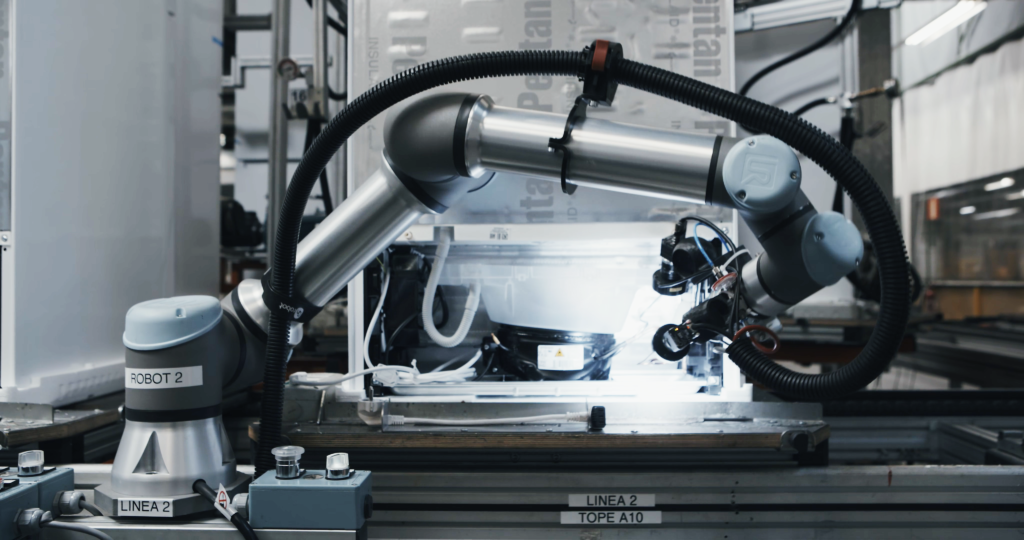
Mit KI und Robotik Handarbeitsplätze automatisieren
Machine Learning, häufig in Kombination mit Machine Vision, kommt auch in den Bereichen Robotik und Automatisierung, Sensorik und bei fahrerlosen Transportsystemen zum Einsatz. Für die Fertigung ist dabei das Zusammenspiel von KI und Robotik ein wichtiger Schlüssel für die Zukunft.
KI-Produkte, wie beispielsweise Robotersteuerungen, ermöglichen es unter anderem, Handarbeitsplätze zu automatisieren. Ein nicht zu vernachlässigender Vorteil, denn Arbeitskräfte sind rar und der Mangel verschärft sich in den Jahren weiter, wie der Deutsche Industrie- und Handelskammertag (DIHK) prognostiziert. Übernehmen Roboter auch Aufgaben, für die es bisher die Flexibilität eines Menschen brauchte, sorgt das für die Entlastung der Stammbelegschaft, eine Auslastung der Maschinen und sichert auf lange Sicht die Wettbewerbsfähigkeit.
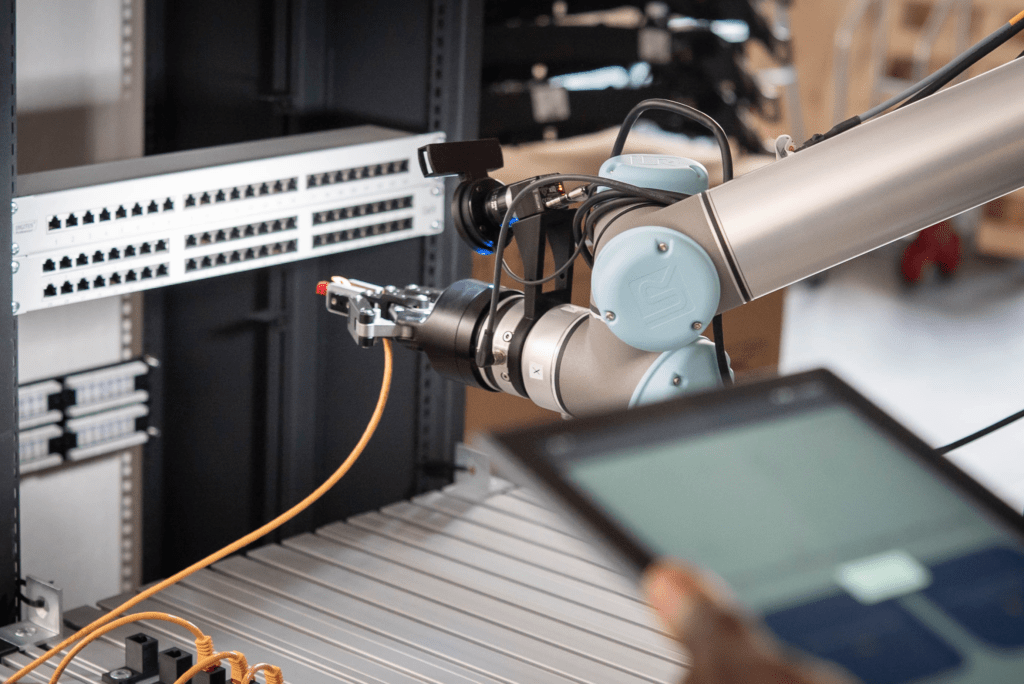
Robuster Umgang mit Varianzen
KI-Steuerungen wie MIRAI von Micropsi Industries ergänzen die native Steuerung eines Roboters. Der Roboter erhält dank einer Kamera und einem neuronalen Netzwerk die Auge-Hand-Koordination und eine vergleichbare Flexibilität wie ein Mensch. Ein solches intelligentes Robotersystem lernt bei neuen Aufgaben, bei anders geformten oder positionierten Werkteilen oder bei vergleichbaren Varianzen schnell, was es zu tun hat und passt bei Bedarf seine Bewegungen in Echtzeit eigenständig an. Ob es sich um das Picken einzelner Teile, Zustellbewegungen oder Fügen und Verfolgen handelt: Zahlreiche Tätigkeiten sind mit einer einzigen kleinen Kamera am Roboter-Handgelenk umsetzbar.
Diese Fähigkeiten lassen sich mit MIRAI durch menschliche Demonstration trainieren. Weder KI- noch Programmierkenntnisse sind erforderlich. Das Know-how bleibt selbst ohne KI-Fachkräfte im Unternehmen. Dem Roboter muss dafür das Ziel einige Male in typisch vorkommenden Varianzen mit der Kamera gezeigt werden. Die KI verallgemeinert im Anschluss die gezeigten Daten. Ein solches System kann in wenigen Stunden trainiert und sogar neu trainiert werden. Selbst eine Fertigung im High Mix-/Low-Volume lässt sich so rentabel automatisieren. Was intelligente Robotiklösungen bereits in der Praxis leisten, zeigen die folgenden Beispiele.
Intelligentes Handling-System bei ZF
Der Technologiekonzern ZF stand vor der Herausforderung, die Werkstückzufuhr einer großvolumigen Frässtation, in der Zahnräder produziert werden, zu automatisieren. Im Werkprozess werden Metallringe aus einer Kiste entnommen und auf ein Förderband gelegt, um später in die Produktion der Zahnräder einzufließen. Die Schwierigkeit: Der Produktionsschritt ist sehr variantenreich, da sich die Ringe in der angelieferten Gitterbox verschieben und dadurch zufällig angeordnet sind. Auch Platzierung und Form der Box variieren. Wechselnde Lichtverhältnisse stellen eine zusätzliche Herausforderung dar. Außerdem ist die Oberfläche der Ringe metallisch glänzend, teilweise ölverschmiert oder korrodiert, was eine klassische Automatisierung unmöglich machte.
Heute ist die KI-Steuerung MIRAI und ein Cobot vom Modell UR10e bei ZF in einer automatisierten Werkstückaufnahme im Einsatz. Mit seiner eigenen Steuerung bringt der Cobot sich über den Ringen in der Kiste in Position. Nun übernimmt das MIRAI-System die Kontrolle: Es bewegt den Roboter selbstständig zum nächsten Ring und bringt den Greifer in die korrekte dreidimensionale Greifposition. Danach übernimmt der UR10e wieder, nimmt den Ring auf und bewegt ihn zum Ablegen auf das Förderband. Das komplette Einrichten des Roboters dauerte lediglich wenige Tage – MIRAI löste in kürzester Zeit ein lang bestehendes Problem.
BSH sucht mit KI nach Kältemittellecks
An ihrem spanischen Standort stellt die BSH Hausgeräte GmbH Kühl- und Gefrierschränke her. Im Herstellungsprozess muss das Unternehmen die Kupferrohrleitungen der Kühlschränke auf Leckagen testen. Für die sogenannte Dichtheitsprüfung wird eine Schnüffelsonde entlang der Kupferrohrleitungen und Kompressoren geführt, um Lötstellen auf austretendes Gas und Kältemittel zu prüfen. Das Besondere: Jede Rückseite der hergestellten Kühlschränke ist einzigartig, was Position, Farbe und Form der Lötpunkte angeht. Für einen herkömmlichen Roboter sind solche Varianzen ein unüberwindbares Hindernis. Der monotone Prüfprozess blieb dem Menschen vorbehalten – bis jetzt.
Den Prüfprozess übernimmt bei BSH nun eine Robotik-Komplettlösung den Prüfprozess. Dank der integrierten Robotersteuerung MIRAI ist es dem Roboter möglich, alle zu prüfenden Lötstellen verlässlich zu identifizieren und die Schnüffelsonde millimetergenau heranzuführen – unabhängig von Position, Form oder Farbe. Das System reagiert in Echtzeit auf seine Umwelt und handhabt selbst unvorhergesehene Abweichungen präzise. Die Roboterfähigkeiten wurden von Mitarbeitenden bei BSH durch menschliche Demonstration in nur wenigen Stunden trainiert. Weder Programmier- noch KI-Kenntnisse waren erforderlich. BSH konnte mit der Automatisierungslösung die laufenden Betriebskosten senken und Wartungen und Fehlerbehebungen reduzieren.

Neue Technologien als Wettbewerbsvorteil
Die Beispiele zeigen, dass Unternehmen mit KI sehr viel bewirken können: KI ermöglicht mehr Flexibilität, Unabhängigkeit, Effizienz und nicht zuletzt Resilienz. Nicht unwichtig in Zeiten wie diesen. Neue Technologien sollte dabei als Türöffner zu mehr Automatisierung verstanden werden. Leistungen, die bislang von Menschen oder Maschinen erbracht wurden, können nun von einer Software geliefert werden. Das ist nicht nur vorteilhaft beim drastisch zunehmenden Arbeitskräftemangel. Es erhöht auch die Flexibilität, Nachvollziehbarkeit und Zuverlässigkeit von Produktionsprozessen und verschafft einen dauerhaften Wettbewerbsvorsprung.
Weitere Informationen unter: https://bit.ly/MicropsiIndustries
Draper Teaches Robots to Build Trust with Humans – new research
New study shows methods robots can use to self-assess their own performance
CAMBRIDGE, MASS. (PRWEB) MARCH 08, 2022
Establishing human-robot trust isn’t always easy. Beyond the fear of automation going rogue, robots simply don’t communicate how they are doing. When this happens, establishing a basis for humans to trust robots can be difficult.
Now, research is shedding light on how autonomous systems can foster human confidence in robots. Largely, the research suggests that humans have an easier time trusting a robot that offers some kind of self-assessment as it goes about its tasks, according to Aastha Acharya, a Draper Scholar and Ph.D. candidate at the University of Colorado Boulder.
Acharya said we need to start considering what communications are useful, particularly if we want to have humans trust and rely on their automated co-workers. “We can take cues from any effective workplace relationship, where the key to establishing trust is understanding co-workers’ capabilities and limitations,” she said. A gap in understanding can lead to improper tasking of the robot, and subsequent misuse, abuse or disuse of its autonomy.
To understand the problem, Acharya joined researchers from Draper and the University of Colorado Boulder to study how autonomous robots that use learned probabilistic world models can compute and express self-assessed competencies in the form of machine self-confidence. Probabilistic world models take into account the impact of uncertainties in events or actions in predicting the potential occurrence of future outcomes.
In the study, the world models were designed to enable the robots to forecast their behavior and report their own perspective about their tasking prior to task execution. With this information, a human can better judge whether a robot is sufficiently capable of completing a task, and adjust expectations to suit the situation.
To demonstrate their method, researchers developed and tested a probabilistic world model on a simulated intelligence, surveillance and reconnaissance mission for an autonomous uncrewed aerial vehicle (UAV). The UAV flew over a field populated by a radio tower, an airstrip and mountains. The mission was designed to collect data from the tower while avoiding detection by an adversary. The UAV was asked to consider factors such as detections, collections, battery life and environmental conditions to understand its task competency.
Findings were reported in the article “Generalizing Competency Self-Assessment for Autonomous Vehicles Using Deep Reinforcement Learning,” where the team addressed several important questions. How do we encourage appropriate human trust in an autonomous system? How do we know that self-assessed capabilities of the autonomous system are accurate?
Human-machine collaboration lies at the core of a wide spectrum of algorithmic strategies for generating soft assurances, which are collectively aimed at trust management, according to the paper. “Humans must be able to establish a basis for correctly using and relying on robotic autonomy for success,” the authors said. The team behind the paper includes Acharya’s advisors Rebecca Russell, Ph.D., from Draper and Nisar Ahmed, Ph.D., from the University of Colorado Boulder.
The research into autonomous self-assessment is based upon work supported by DARPA’s Competency-Aware Machine Learning (CAML) program.
In addition, funds for this study were provided by the Draper Scholar Program. The program gives graduate students the opportunity to conduct their thesis research under the supervision of both a faculty adviser and a member of Draper’s technical staff, in an area of mutual interest. Draper Scholars’ graduate degree tuition and stipends are funded by Draper.
Since 1973, the Draper Scholar Program, formerly known as the Draper Fellow Program, has supported more than 1,000 graduate students pursuing advanced degrees in engineering and the sciences. Draper Scholars are from both civilian and military backgrounds, and Draper Scholar alumni excel worldwide in the technical, corporate, government, academic, and entrepreneurship sectors.
Draper
At Draper, we believe exciting things happen when new capabilities are imagined and created. Whether formulating a concept and developing each component to achieve a field-ready prototype, or combining existing technologies in new ways, Draper engineers apply multidisciplinary approaches that deliver new capabilities to customers. As a nonprofit engineering innovation company, Draper focuses on the design, development and deployment of advanced technological solutions for the world’s most challenging and important problems. We provide engineering solutions directly to government, industry and academia; work on teams as prime contractor or subcontractor; and participate as a collaborator in consortia. We provide unbiased assessments of technology or systems designed or recommended by other organizations—custom designed, as well as commercial-off-the-shelf. Visit Draper at http://www.draper.com.
